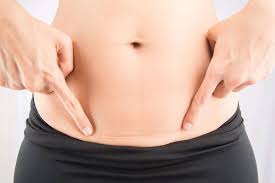C-Section is Major Abdominal Surgery
Before we discuss C-section massage, it’s important to note that a Caesarean section birth is major abdominal surgery. It involves incisions to many layers of tissue and this requires adequate time for healing and recovery. It is recommended you see a specialist women’s health physiotherapist after 6 weeks to assess healing, your pelvic floor and to commence appropriate abdominal strengthening exercises.
During a c-section the first incision is usually made horizontally just above the pubic line cutting through the skin and subcutaneous layer (fat). The second, through the rectus sheath (thick layer of connective tissue called fascia), which secures the rectus abdominus muscles (most superficial abdomen muscles). The rectus abdominal muscles are separated and pulled, rather than cut.
Another incision is made through the parietal peritoneum (internal layer of connective tissue/fascia), then the loose peritoneum and then finally and carefully the uterus, which is a very thick muscular layer. Once the baby is delivered each one of these layers will be stitched up again, but the muscle and the fascia will usually have to reform their own bond. Scar tissue will continue to develop anywhere from 9 months or up to 2 years.
C-Section Scar Tissue
The scarring throughout these abdominal layers affects the abdominal muscle strength and integrity, which results in weakness and instability. Working with a specialist pelvic physiotherapist pre and post-natal, whether you have had a vaginal birth or C-section birth, can assist with regaining your core strength.
Scar tissue will form where the uterus was cut, as well as the surrounding connective tissue. This scarring can weaken the uterus muscle wall and affect the bladder by stretching the bladder wall. This can potentially increase the urge to pass urine. Abdominal massage can assist in releasing the fascia of the abdomen and help reduce the likelihood of adhesions, making it safer for future pregnancies.
Adhesions occur when the scar sticks to the underlying tissue. This can lead to musculoskeletal impairments and chronic pain. Often one side of the scar will feel tighter than other, which can create tightness and pulling of the position of the uterus. This can affect the utero sacral ligaments, pulling on the sacrum and restricting movement of the sacroiliac joint. This may ultimately cause lower back pain and possibly a pelvic rotation.
C-Section Scar Massage
Scar tissue massage helps to soften scar tissue and assists with movement of the skin during daily movements. Massaging your scar regularly will help prevent adhesions forming. Studies show soft tissue mobilisation techniques (massage) have great benefits including:
- Encourages healing of the scar, superficially and deep to incision.
- Desensitizes the area.
- Reduces pain
- Reduces adhesions and scar tissue
In the first 6 – 8 weeks after birth you will be getting settled into a new routine and trying to get as much rest as possible. Once you have clearance from your doctor you can consult with a specialist women’s health pelvic physiotherapist (read more here). Together you can make a plan to get back to exercise and moving a bit more.
Once the scar is fully healed (also around 6 weeks) scar tissue massage can also be commenced. You can start by lightly massaging above and below your c-section scar to assist with desensitising the area. Some women might feel uncomfortable touching their scar or having someone else touch it, and this may especially be true if the caesarean was unplanned. Desensitising the area can assist with this, and you can use different materials such as cotton balls, bath towels and denim. Doing this daily will reduce sensitivity over time.
Your physio will teach you to perform self-massage and can also provide you gentle stretches to help regain full mobility of the skin. After 12 weeks your physios can perform direct scar mobility and deeper layer mobilisation.
Caesarean’s can sometimes be a traumatic experience depending on the circumstances. Treating the C-section scar with massage can help work through difficult emotions, and is therapeutic beyond the physical.
C-section massage is performed by a qualified physiotherapist. If you would like to know more or book in for a treatment email our friendly admin team for assistance info@portmelbournephysio.com.au

